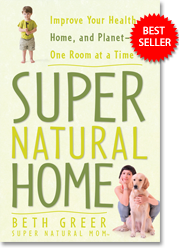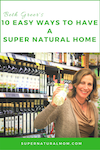According to the Environmental Protection Agency, the air we breathe inside our homes could be as much as five times as polluted as the air outside. One major reason: Common cleaning products contain chemicals that can be more dangerous than the germs themselves. Every time our children roll around on the carpet or our pets lick crumbs off the floor, they are being exposed to chemicals.
Many of us, in our zeal to make our homes a safe haven, take clean to an extreme. Each year, according to the Montana Department of Environmental Quality, the average American uses approximately 25 gallons of toxic and hazardous chemical products at home, much of which is eventually washed down the sink, flushed down the toilet or placed in a garbage can, potentially affecting the health of the people, plants, animals, land and water in and around our neighborhoods. The department contends that of the roughly 17,000 chemicals found in common household products, only 3 in 10 have been tested for their effects on human health.
The U.S. Consumer Product Safety Commission is the agency responsible for the safety of consumers using thousands of products — from toys and cribs to power tools and household chemicals. The commission does not require manufacturers to test household cleaning products before they appear on store shelves, so much of the information consumers have about a product comes from its label. Labels are required to provide hazard symbols, such as “poison” and “flammable,” and must give information about first aid treatments for those ingredients.
But according to the Children’s Health Environmental Coalition, a national nonprofit that educates the public on environmental toxins that affect children’s health, labels often omit inactive or inert ingredients that can make up as much as 90 percent of a product’s volume. These include solvents, dispersal agents, dyes and fragrances, some of which can pollute the air and water. Other ingredients can be suspected carcinogens or worsen long-term health problems such as allergies and asthma. Diethyl phthalate, commonly found in commercial cleaning products, is a known endocrine-disrupting chemical (which can interfere with normal growth and development). Toluene, a chemical found in some stain removers, has been classified by the EPA as a carcinogen — and studies have linked it to neurological problems and birth defects.Another thing to watch out for are aerosol sprays that contain flammable and nerve-damaging ingredients such as hexane and xylene.
Also, aerosol sprays produce mist particles that can contain a high proportion of organic solvents, according to the Massachusetts Water Resources Authority. It warns that these solvents can be inhaled into the lungs and enter the bloodstream. According to a 1999 study published in the weekly science and technology magazine New Scientist, in homes where aerosol sprays and air fresheners were used frequently, mothers experienced 25 percent more headaches and were 19 percent more likely to suffer from depression, and infants younger than 6 months old had 30 percent more ear infections and a 22 percent higher incidence of diarrhea.
Labels provide only limited information, but there are other ways to make sure you’re keeping your family safe from indoor pollutants. They include:
— Be wary of products that make cleaning too easy. If you don’t need to scrub at least a little bit, you should question why. These cleansers can emit fumes (even while stored) that can affect a home’s air quality.
— Air fresheners contain synthetic fragrances, or phthalates, chemicals that have been linked to cancer and reproductive-system harm in rodents. Some groups cite evidence linking phthalates to the same problems in humans.
— While it shouldn’t be assumed that because an item is on the shelf it has been tested for safety, you also shouldn’t assume that if it says “natural” it’s safe. The word “natural” is undefined and unregulated by the government and can be applied to just about anything.
— Because no standards exist, claims like “eco-safe” and “environmentally friendly” are also meaningless, says the Consumers Union. Since only food and herbs can be certified organic, the word “organic” on the label of a dish or laundry soap doesn’t mean much.
— Most conventional dish and laundry detergents are made from petroleum, a nonrenewable synthetic resource, so look for naturally derived or plant-based formulas that are biodegradable and contain no phosphates.
— Fabric dryer sheets and potpourri that list “fragrance” on the label mean that synthetic (i.e., petroleum-based) chemicals were used, and they should be avoided.
— Choose “non-chlorine bleach” cleaning solutions and scouring powders. Fumes of cleansers containing a high concentration of chlorine can irritate the lungs, which is dangerous for those with asthma, emphysema or a heart condition. The risks are compounded when the cleansers are used in small, poorly ventilated rooms, such as the bathroom. Fragranced chlorine bleaches are even worse because the odor is disguised, which can lead to dangerous overexposure.
— If you use air fresheners, try using non-aerosol citrus sprays containing only citrus peel extracts, which are effective at dissolving airborne odors. Try an open box of baking soda to remove odors, or use sachets of dried flowers and herbs, or lavender essential oil, which will provide gentle scents.
— White vinegar, borax, salt, herbs, olive oil, cornstarch and lemon juice have been used as cleansers for decades and have proved to be effective and safer for humans, pets and the environment.
If all this seems overwhelming, think about just one “healthy” cleaning product you can buy today and commit yourself to buying it. This small, simple act could have a big effect on your family’s health.
Recipes to make environmentally safe cleansers from oven cleaners to mildew removers can be found online at: www.care2.com, www.almanac.com (hit the Food button, then scroll down to “Kitchen Tips and Tricks” and click on the “helpful advice and handy kitchen hints link”) and www.organizedhome.com.
Information about safe cleaning products can be found at: www.greenhome.com, www.checnet.org (Children’s Health Environmental Coalition), www.householdproducts.nlm.nih.gov and www.kidsorganics.com/Chemicals%20to%20Avoid.htm.
You can find environmentally safe products from Bon Ami, Ecover, Seventh Generation, BioShield, Earth Friendly and Greenwood Naturals (a lavender-based product developed by the Greenwood School in Mill Valley, CA and produced by EO). Natural products are available at online stores and Whole Foods, Molly Stone’s, Good Earth and Trader Joe’s.


